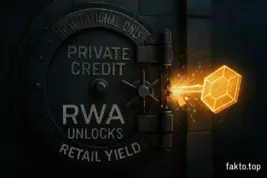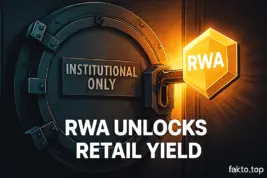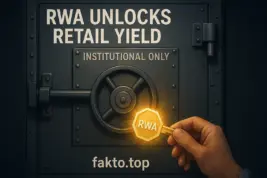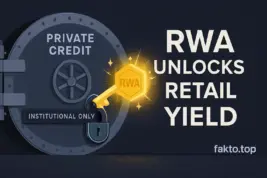The 40T RWA Rush: How Tokenization Will Change Your 401k by 2027
The 40 Trillion Tectonic Shift: Why Tokenization of Real World Assets (RWA) Is the Only Trade for 2026
Something irreversible is happening in global finance. A $40 trillion market—spanning bonds, real estate, and private credit—is quietly migrating onto blockchain rails. This isn’t a crypto fad or a DeFi experiment. It’s the institutional-grade tokenization of Real World Assets (RWA), and by 2026, it will redefine how Western investors build wealth, protect pensions, and generate passive income.
RWA tokenization isn’t about speculation. It’s about infrastructure. It’s about efficiency. And it’s about yield. For the average 401k holder, the shift will feel subtle at first—fewer fees, faster settlement, more flexible access. But under the hood, the transformation is seismic. Wall Street is already moving. BlackRock, Fidelity, and Franklin Templeton are testing tokenized T-Bills and private credit pools. Ethereum is becoming the compliance layer. And the retail investor? They’re next.
Let’s be clear: this is not optional. The legacy financial system is buckling under its own weight—slow settlement cycles, high entry barriers, and layers of costly intermediaries. Tokenization solves these problems. It fractionalizes ownership, unlocks global liquidity, and compresses settlement from days to seconds. For the first time, retail investors can access high-yield instruments once reserved for institutions. And they can do it 24/7, from anywhere.

In this analysis, we’ll break down the mechanics of RWA tokenization, show how it will reshape your portfolio, and explain why 2026 is the inflection point. This is not just a forecast—it’s a roadmap for anyone serious about yield, efficiency, and the future of finance.
How RWA Tokenization Fixes TradFi’s Three Biggest Problems
Liquidity Bottlenecks
Traditional finance is built on delay. Settlement cycles stretch from T+2 to T+5, locking up capital and creating systemic inefficiencies. Tokenized assets settle in seconds. On-chain liquidity means investors can move in and out of positions without waiting days for clearinghouses or custodians. This isn’t just faster—it’s safer. Atomic settlement reduces counterparty risk and eliminates the need for trust-based intermediaries.
Fractional Ownership & Access
Private credit, commercial real estate, and structured debt have historically been gated behind high minimums and accreditation requirements. Tokenization breaks those gates. With fractional ownership, retail investors can access slices of high-yield assets—sometimes for less than $100. This democratization isn’t theoretical. Platforms like Ondo Finance and Centrifuge are already onboarding retail into permissioned pools, backed by real collateral and institutional-grade compliance.
24/7 Settlement and T-Bill Efficiency

The bond market doesn’t work on weekends. Your brokerage account doesn’t yield overnight. But tokenized T-Bills do. With 24/7 access and near-instant settlement, tokenized bonds offer continuous yield and eliminate the drag of custody fees. For pension funds and passive investors, this is a game-changer. It’s not just about access—it’s about compounding efficiency.
| Parameter | Traditional Finance (TradFi) | Tokenized Assets (RWA) |
|---|---|---|
| Settlement Time | T+2 to T+5 days (Requires manual clearing) | Seconds to Minutes (On-chain, atomic settlement) |
| Minimum Investment | High (e.g., 25,000 for Private Credit, Full share for Real Estate) | Low (e.g., <$100 via fractionalization) |
| Intermediary Fees | High (Brokerage, custodian, transfer agents) | Low (Only minimal gas/network fees) |
| Access | Limited (Only 9 a.m. to 5 p.m. M-F) | Global, 24/7/365 |
These aren’t marginal improvements. They’re structural upgrades. And they’re already live. The question isn’t whether RWA tokenization will replace legacy systems—it’s how fast it will happen, and who will benefit first.
This is How RWA Will Change Your 401k and Pension by 2027
For most retail investors, the idea of tokenized bonds or fractional real estate still feels abstract. But the impact on your actual portfolio—your 401k, your pension, your passive income—is about to get very real. By 2027, the shift won’t just be visible. It will be personal.

Here’s what’s coming: tokenized Treasury Bills that settle instantly and yield daily. Private credit pools that no longer require $100,000 minimums or accredited status. Commercial real estate that’s liquid, tradable, and accessible for under $500. These aren’t speculative ideas—they’re already being tested by institutions and deployed on compliant platforms. The result? A portfolio that works harder, costs less, and adapts faster.
Let’s break it down. Traditional portfolios are built around slow-moving assets, high fees, and limited access. Tokenized portfolios flip that model. They offer fractional exposure to high-yield instruments, eliminate intermediaries, and unlock 24/7 liquidity. For the average investor, that means more yield, fewer fees, and better control.
| Asset Class | Traditional Portfolio Barrier | RWA Tokenization Benefit |
|---|---|---|
| Treasury Bonds (T-Bills) | Slow settlement, low liquidity, high custody costs. | 24/7 Yield: Near-instant yield and settlement; zero custody fees. |
| Private Credit | Requires Accredited Status, very high minimums (100k+). | Fractional Access: Opens high-yield assets to retail investors; lower risk through over-collateralization. |
| Commercial Real Estate | Illiquid (years to sell), high management fees, high entry capital. | Immediate Liquidity: Fractional ownership, easy secondary market trading, low entry barrier. |
These shifts aren’t just technical—they’re emotional. For the first time, retail investors can access the same yield engines as institutions. They can build portfolios that reflect their goals, not just what their broker offers. And they can do it without waiting days for settlement or paying layers of hidden fees.
It’s also about trust. Tokenized assets are programmable, transparent, and auditable. You know what you own, how it performs, and where it lives. That’s a level of clarity traditional finance rarely offers. And in a world where pensions are under pressure and passive income is more important than ever, that clarity matters.
By 2027, your 401k won’t just hold stocks and mutual funds. It will include tokenized T-Bills, fractional real estate, and on-chain private credit. And it will do so with better yield, lower fees, and real-time access. That’s not a theory—it’s the roadmap. And it’s already being built.
The Compliance Layer: Why Ethereum is Winning the Digital Securities Race
Tokenizing real-world assets isn’t just about speed and access—it’s about trust, regulation, and infrastructure. And that’s where Ethereum is quietly pulling ahead. While Bitcoin remains a store of value and Solana courts speed, Ethereum is becoming the backbone for compliant financial products. It’s not just the smart contracts—it’s the ecosystem of permissioned pools, KYC/AML protocols, and scalable Layer 2 networks that make it the frontrunner for digital securities.
Let’s start with compliance. Real-world assets require identity verification, jurisdictional controls, and auditability. Platforms like Securitize and Ondo Finance are building on Ethereum precisely because it supports these layers. Permissioned pools allow only verified participants. Smart contracts enforce transfer restrictions. And every transaction is traceable—without compromising privacy. This isn’t DeFi anarchy. It’s regulated finance, rebuilt for efficiency.

Then there’s scalability. Ethereum’s Layer 2 networks—like Arbitrum and Polygon—are solving the throughput problem. They allow tokenized assets to move quickly and cheaply, while anchoring security to the Ethereum mainnet. For institutions, this means compliance without compromise. For retail investors, it means access without congestion. And for developers, it means building financial products that scale globally, without losing regulatory clarity.
But infrastructure goes beyond compliance and speed. It’s about resilience. And that’s where the convergence with DePIN becomes critical. Tokenized assets need physical infrastructure—nodes, compute, bandwidth—to operate reliably. Ethereum provides the logic, but decentralized infrastructure provides the muscle. To understand the full scope of this financial convergence and the resilient backbone required, read our expert forecast on why 500 million users will choose DePIN over banks by 2026.
Ethereum isn’t winning because it’s trendy. It’s winning because it’s modular, compliant, and battle-tested. It’s where institutions are building. It’s where regulators are watching. And it’s where retail investors will find the next generation of yield-bearing assets—wrapped in smart contracts, secured by decentralized infrastructure, and ready for global adoption.
The 2026 Outlook: Winners, Losers, and the End of the Liquidity Trap
By 2026, the financial landscape will look radically different. The winners will be those who embraced tokenization early—retail investors who shifted into on-chain T-Bills, institutions that built compliant pools, and platforms that prioritized transparency and speed. The losers? Legacy custodians, slow-moving brokerages, and intermediaries clinging to outdated settlement cycles.
This isn’t just about technology—it’s about capital flow. As tokenized assets prove their efficiency, capital will migrate. Pension funds will reallocate. Retail investors will demand better yield. And Wall Street will follow the liquidity. The liquidity trap—where trillions sit idle due to slow settlement and high fees—will begin to unwind. And with it, the old rules of portfolio construction will collapse.
Custody will become code. Settlement will become seconds. And yield will become global. Investors won’t ask “Is this asset tokenized?”—they’ll ask “Why isn’t it?” The shift will be so fundamental that even regulators are preparing for it. The SEC is already reviewing tokenized securities frameworks. The UK’s FCA is exploring digital asset custody. And institutions are quietly building the infrastructure to support it all.
For the retail investor, this means opportunity. Not just to earn more—but to understand more. To see exactly what they own, how it performs, and how it fits into a broader financial ecosystem. It’s a level of control and clarity that traditional finance rarely offered. And it’s arriving faster than most expect.
RWA tokenization isn’t a niche. It’s the new default. And by 2026, it will be the backbone of every serious portfolio—from pension funds to personal wallets. The tectonic shift has already begun. The only question left is whether you’ll be positioned to benefit from it.
Disclaimer
This article is for informational purposes only and does not constitute financial advice, investment recommendations, or legal guidance. All forecasts and analyses are based on current market data as of October 2025 and are subject to change. Readers should conduct their own due diligence and consult with licensed professionals before making any investment decisions. The mention of specific platforms, protocols, or financial products does not imply endorsement. Investing in tokenized assets involves risk, including potential loss of capital. fakto.top assumes no liability for actions taken based on this content.
